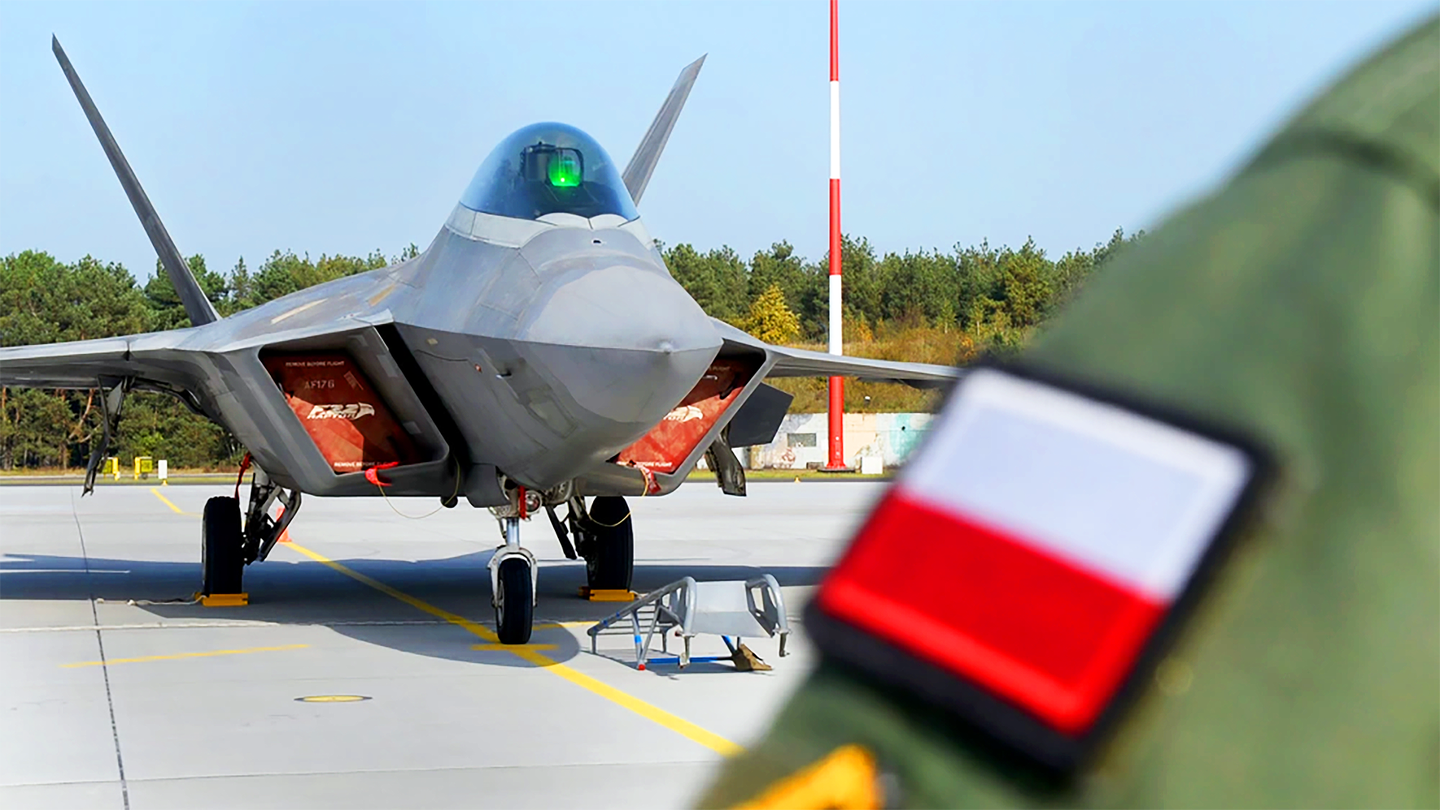F-22 Raptors Arrive in Poland
The F-22 Raptor fighter jets will provide a major upgrade for NATO’s air shielding mission spanning from the Baltic to the Black Sea.

Today, the U.S. Air Force in Europe released a statement detailing that 12 U.S. Air Force F-22 Raptors assigned to the 90th Fighter Squadron forward deployed to the 32nd Tactical Air Base in Łask, Poland. Current reports dictate that six of those Raptors have now arrived in support of NATO’s ‘air shielding’ mission, which is centered around deterring “any possible Russian aggression” and shielding the airspace along NATO’s Eastern borders.
The deployment is unprecedented for the Raptor force, which had just sent a pair of Raptors to Poland a few years ago as a goodwill and training drill. It’s also the first time the F-22 has been deployed to Europe since Russia’s invasion began. You can read our initial reporting on the F-22’s arrival in Europe which details how unique the deployment is here.
The fifth-generation stealth fighters were chosen for this particular NATO mission because of their “ability to provide lethality and survivability against any emerging high-end threats,” according to the USAF.
“The NATO Air Shielding mission integrates Allied Air and Surface Based Air and Missile Defense units into the NATO Integrated Air and Missile Defense system under NATO Command and Control,” read a USAF press release. “It will provide a near seamless shield from the Baltic to Black Seas, ensuring NATO Allies are better able to safeguard and protect Alliance territory, populations and forces from air and missile threat.”
The F-22s of the 90th Fighter Squadron, based far away in Alaska, will take over the Vermont Air National Guard’s 158th Fighter Wing’s mission, which has been using its fleet of F-35 Lightning IIs to execute the coalition’s air policing mission since their arrival in-theater on May 2. The F-35 Lightening II three-month long rotational deployment was completed at Spangdahlem Air Base in Germany and returned to Vermont on August 3.
In addition to the F-35s, the Air Force noted that eight F-15Es from the 336th Fighter Squadron, 4th Fighter Wing were deployed to Lask, Poland, and six KC-135 Stratotankers from the 100th Aerial Refueling Wing were deployed to Ramstein Air Base, Germany. The Air Force, though, expects that the transition from the 158th Fighter Wing’s F-35 force to the 90th Fighter Squadron’s F-22s will be seamless in its integration with NATO’s air shielding mission.
“A combination of sensor capability, integrated avionics, situational awareness, and weapons provides first-kill opportunity against threats,” read a USAF press release. “The F-22 possesses a sophisticated sensor suite allowing the pilot to track, identify, shoot and kill air-to-air threats before being detected. It cannot be matched by any known or projected fighter aircraft, making it a highly strategic platform to support NATO Air Shielding.”
Sending a dozen of the most potent air-to-air fighters on the planet to the border of Ukraine certainly sends a strong message to Russia — don’t try anything.
Before we get into more details about the past few days of fighting in Ukraine, you can catch up on our previous rolling coverage of the war here.
The Latest
According to the U.K. Ministry of Defense’s latest defense intelligence update, Russian forces are continuing ground attacks northwest of the city of Slovyansk. Several bordering areas of regions currently occupied by Russian forces are becoming increasingly contested as can be seen on the map as well. Russian units are still trying to advance elsewhere in the Donbas region.
Ukraine has made it clear that the country will sever diplomatic ties with neighboring Belarus if its military decides to cross the border, the Kyiv Independent reported. The declaration comes amid Belarussian troop readiness exercises that are being conducted near the Ukrainian border. Russia used Belarus as a major vector for its invasion in February.
Videos and images have begun circulating online showing what appears to be Russian naval actions off the coast of Crimea. They depict at least two separate vessels, one of which appears to be emanating plumes of dark smoke in the waters north of Crimea. This could be the result of a Ukrainian attack, however, that claim is unconfirmed at this time. Two additional images show what appears to be a Russian patrol ship near Sevastopol obscured by tall sprays of seawater or smoke reminiscent of a countermeasures salvo.
This intriguing occurrence is still developing, and The War Zone will be sure to provide an update if more information becomes available.
The first Ukrainian grain ship to leave the country and sail through the Black Sea has passed inspections in Istanbul and is now en route to Lebanon. According to the Associated Press, the joint civilian inspection team took three hours to complete the procedure, which mostly consisted of checking the crew and cargo for any illegally obtained products, like stolen grain. In fact, a ship that Ukraine insists is currently carrying stolen grain, the Syrian-flagged Laodicea, has now left a Lebanese port following the approval of Lebanon’s transport minister.
However, the Sierra Leone-flagged ship Razoni left the port of Odesa on Aug. 1 carrying with it 26,000 tons of corn while an additional 22 million tons of Ukrainian grain remains loaded onto 17 other vessels that are waiting for permission to depart. The safe passage of the Razoni grain ship was administered under an agreement between Ukraine, Turkey, the United Nations, and Russia who last month signed a deal to impose safe shipping lanes in the Black Sea for the export of the agricultural products that nations around the world are in desperate need of.
Foreign assistance, namely from the United States, has led Russia to accuse the country of having a direct role in the war in Ukraine. According to the BBC, a spokesperson for Russia’s Ministry of Defense alleged that the United States was “approving targets for American-made HIMARS [High Mobility Artillery Rocket Systems] artillery used by Kyiv’s forces” after intercepted calls purportedly revealed the assistance. BBC itself noted that the outlet was not able to independently verify the claim.
As noted in The War Zone’s previous Ukraine Situation Report, as well as in much of our coverage of the conflict, HIMARS have garnered quite the cult following since the United States began delivering them to Ukraine in various aid packages. HIMARS paired with M31 Guided Multiple Launch Rocket System (GMLRS) rockets have proven to be a key capability for Ukrainian forces in various bridge-busting and ammo depot-destroying operations, but the rapid transfer and high use of these systems have also raised concerns about meeting the wartime demand. You can read The War Zone’s deep-dive on concerns surrounding GMLRS stockpiles here.
A video recently shared by Ukraine Weapons Tracker on Twitter began circulating on social media showing no less than four M142 HIMARS ostensibly firing approximately 24 M31A1 GMLRS rockets allegedly at Russian targets. It serves as a reminder of HIMARS’ destructive power and also of just how fast a force can burn through the $166,000 guided artillery rockets.
Russian shelling has continued in a city near the Zaporizhzhia nuclear power plant, Europe’s largest, further supporting warnings issued by the International Atomic Energy Agency insisting that the situation at the plant has gotten out of control. According to the Associated Press, the city of “Dnipropetrovsk’s regional governor said Russia fired 60 rockets at Nikopol, across the Dnieper River from the Zaporizhzhia nuclear plant.”
You can read more about the precarity unfolding at the Zaporizhzhia nuclear power plant in this recent War Zone piece here.
Bridges continue to be a major target for HIMARS considering the logistical importance they present for the delivery of supplies, personnel, and equipment needed to support Russia’s invasion and occupation operations. River crossing points are also key to Ukrainian defenders. Videos of Russian loitering munitions taking out Ukrainian pontoon bridges have begun to surface, as well as footage of Russian ferry crossings now cleared for civilian use taking place near the highly targeted and recently shelled Antonivskiy Bridge.
Ukrainian HIMARS attacks began striking the Antonovskiy Bridge above the Dnipro River in Kherson on July 20, and additional hits about a week later also put the Antonivskiy Railway Bridge, which is a few miles upstream from the civilian bridge, out of commission. Both strikes are believed to be a revitalized counteroffensive effort on the part of Ukrainian forces to take back the Kherson region. You can read about the preparations Russia is carrying out to prevent further strikes here.
Speaking of Kherson, the U.K. Ministry of Defense claims that the aftermath of a Ukrainian attack on a Russian ammunition train at the Brylevka rail station in Kherson’s southern region may have rendered the rail link connecting the city with Crimea inoperable. Even though Russian forces are likely to repair the rail link in the coming days, its status as an essential resupply route will certainly maintain its vulnerability to future Ukrainian artillery strikes.
The Institute for the Study of War (ISW) has detailed that Russian forces likely set fire to the Olenivka prison on July 28 and are now attempting to place the blame on a Ukrainian HIMARS strike. The ISW has tweeted that Russia has refused to provide specific information on which Ukrainian prisoners of war were killed or injured in the attack.
A more detailed version of this report on the ISW website explained that Ukrainian Main Military Intelligence Directorate representative Andriy Yusov revealed how requests made by Ukraine’s Coordinating Headquarters for the Treatment of POWs for information about casualties had been sent to Russia, but no response has been received.
The ISW has also reported that Russia is likely continuing its efforts to work with Iran in order to skirt sanctions and receive shipments of drones to be used in Ukraine. The ISW reached this conclusion not only because rumors of this exchange have been circulating for weeks now, but also because Russia’s state-owned space agency Roscosmos recently announced it will be launching a remote-sensing satellite into orbit on behalf of Iran. ISW has theorized that this launch will be in either repayment of or encouragement for the provision of Iranian drones.
To counter the overall drone threat that has proliferated throughout the conflict, a number of high-tech counter-unmanned aerial systems weapons have begun appearing in both Ukrainian and Russian hands, as well.
We will continue to update this post until we state otherwise.
Contact the author: [email protected]

MORE TO READ
" Conservative News Daily does not always share or support the views and opinions expressed here; they are just those of the writer."

Now loading...